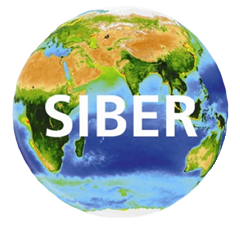ESSO - Indian National Centre for Ocean Information Services
(An Autonomous Body under the Ministry of Earth Sciences, Govt. of India)
SIBER Themes
To address the long-term goal SIBER has structured its research around six scientific themes. Each of these include a set of scientific questions that need to be addressed in order to improve our understanding of the biogeochemical and ecological dynamics of the Indian Ocean and develop a capability to predict future changes. These themes can be broadly separated into three that are regionally focused and three that address broad scientific questions.
Regional Scientific Themes:
Theme 1:
Boundary current dynamics, interactions and impacts (How are marine biogeochemical cycles and ecosystem processes in the Indian Ocean influenced by boundary current dynamics?)
Core Questions:
-
What are the biogeochemical and ecological impacts of seasonally reversing currents in the northern Indian Ocean?
What are the biogeochemical and ecological impacts of the poleward flowing boundary currents of the southern Indian Ocean?
How do the mechanisms that cause mesoscale eddies vary between the Arabian Sea and Bay of Bengal?
How do local and remote forcing mechanisms and the ITF combine to prescribe the physical environment that in turn drives variability in the biological distributions, primary productivity and export flux of the STIO?
What biophysical mechanism(s) associated with semi-annual Wyrtki Jets drive seasonal biogeochemical and ecological variability within the equatorial waveguide?
-
What impact on the stocks and fluxes of the pelagic ecosystem is incurred during intraseasonal or episodic events and how significantly do these contribute to regional or local biogeochemical budgets?
-
How does the fundamental IOD-engendered transformation of the Indian Ocean's ecosystem affect regional biogeochemical fluxes, fisheries activities and the impact of higher frequency forcings, and to what degree are these responses a preview of climate change?
How do natural and anthropogenic forcing influence ecosystem structures and biogeochemical processes within the OMZ in the Arabian Sea and the Bay of Bengal?
How will export fluxes respond to environmental changes and how will resulting variations in the quantity and quality of export fluxes affect midwater and benthic processes in the AS and BoB?
How will climate and land use changes affect internal (upwelling, vertical mixing) and external deliveries of nutrients and ballast material to surface waters and how will food web structures and export fluxes respond to these changes in the BoB and the AS?
What role do the marginal seas play in determining productivity and how do their outflows affect mid-water oxygen concentrations in the AS and the BoB?
How does phytoplankton production and its controlling factors vary across the Indian Ocean and with season?
What fraction of phytoplankton production is exported to the deep sea, and how are the benthic communities, and mid-water and benthic processes driven by this export?
How do these phenomena vary, with season, from abyssal plain to continental shelf, and between Indian Ocean basins?
-
The fast increase of anthropogenic CO2 in the atmosphere provokes two main impacts on the oceans: seawater warming and ocean acidification. In the IO, these impacts of the anthropogenic greenhouse CO2 gas are particularly important. How have warming and acidification influenced biogeochemical cycles and ecosystem dynamics in the Indian Ocean in the Anthropocene and what will their impacts be in the future?
Human population is predicted to increase markedly over the next 50 years in southern Asia . This increase will give rise to increased coastal development and a wide range of related human impacts. How are present day increases in human populations and coastal development influencing biogeochemical cycles and ecosystem dynamics in the coastal zone of the Indian Ocean and how will these impacts be manifested in the future?,/p>
As discussed in Theme 2, in addition to the influence of the seasonal monsoon cycle, the IO is influenced by natural cycles in climate variability, for example, the Madden-Julian Oscillation (MJO) and the Indian Ocean Dipole (IOD), the Wyrtki Jets and major cyclones. What are the IO biogeochemical and ecosystem responses to these modes of climate variability?
At lower levels of the food web, where small consumers interact most intimately with primary producers and biogeochemical cycling, what are their roles in regulating the composition and structure of planktonic communities and the magnitudes and directions of carbon and nutrient fluxes?
At intermediate and higher trophic levels, what are the dynamics, impacts and vulnerabilities of dominant stocks/populations like myctophids, and how do their biomass variations affect lower trophic levels and vice versa?
At the top of the trophic hierarchy, what are the climate and human (fisheries) influences on major predator stocks (such as tuna) that could exert top-down pressures on the functioning of food webs?
Theme 2:
Variability of the equatorial zone, southern tropics and Indonesian throughflow and their impacts on ecological processes and biogeochemical cycling (How do unique physical dynamics of the equatorial zone of the Indian Ocean impact ecological processes and biogeochemical cycling?)
Core Questions:
Theme 3:
Physical, biogeochemical and ecological contrasts between the Arabian Sea and the Bay of Bengal (How do differences in natural and anthropogenic forcing impact the biogeochemical cycles and ecosystem dynamics of the Arabian Sea and the Bay of Bengal?)
Core Questions:
General Scientific Themes:
Theme 4:
Controls and fates of phytoplankton and benthic production in the Indian Ocean (What are the relative roles of light, nutrient and grazing limitation in controlling phytoplankton production in the Indian Ocean and how do these vary in space and time? What is the fate of this production after it sinks out of the euphotic zone?)
Core Questions:
Theme 5:
Climate and anthropogenic impacts on the Indian Ocean and its marginal seas (How will human-induced changes in climate and nutrient loading impact the marine ecosystem and biogeochemical cycles?)
Core Questions:
Theme 6:
The role of higher trophic levels in ecological processes and biogeochemical cycles (To what extent do higher trophic level species influence lower trophic levels and biogeochemical cycles in the Indian Ocean and how might this be influenced by human impacts, e.g., commercial fishing?)




